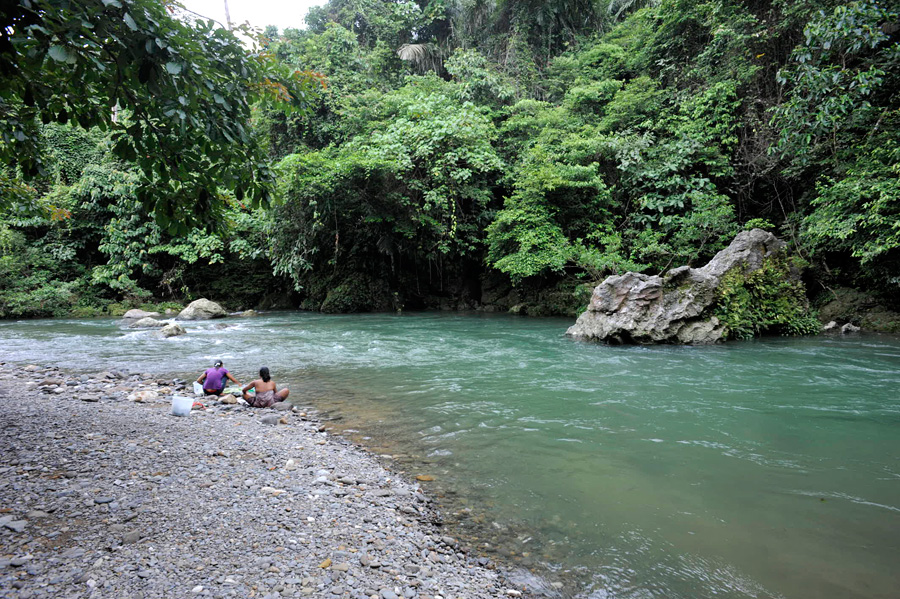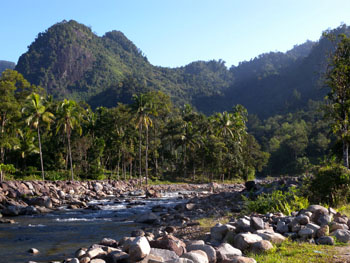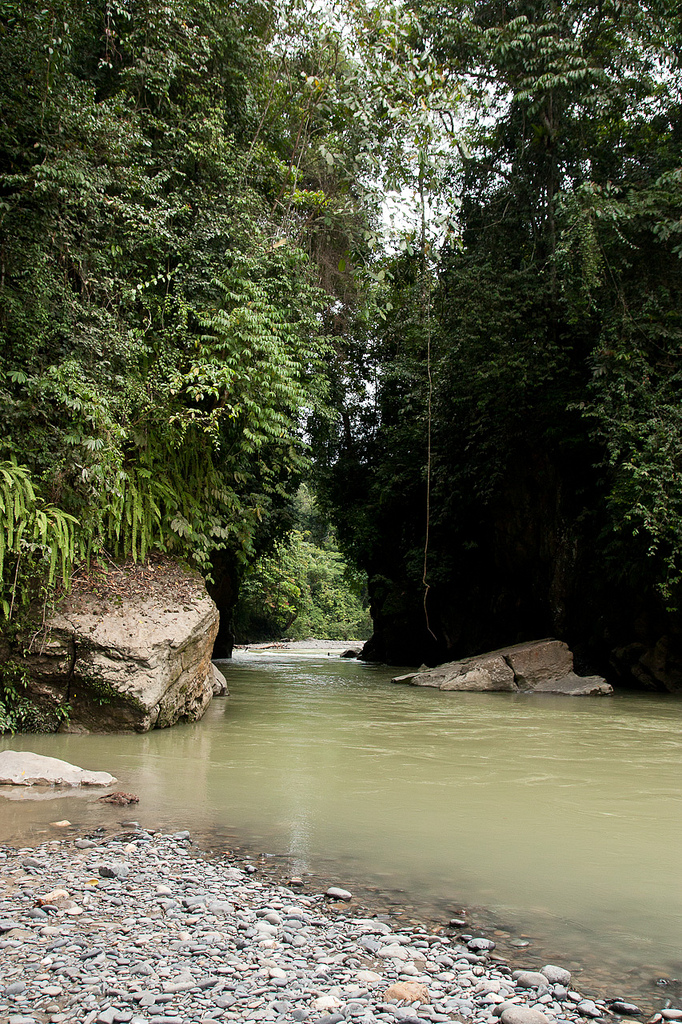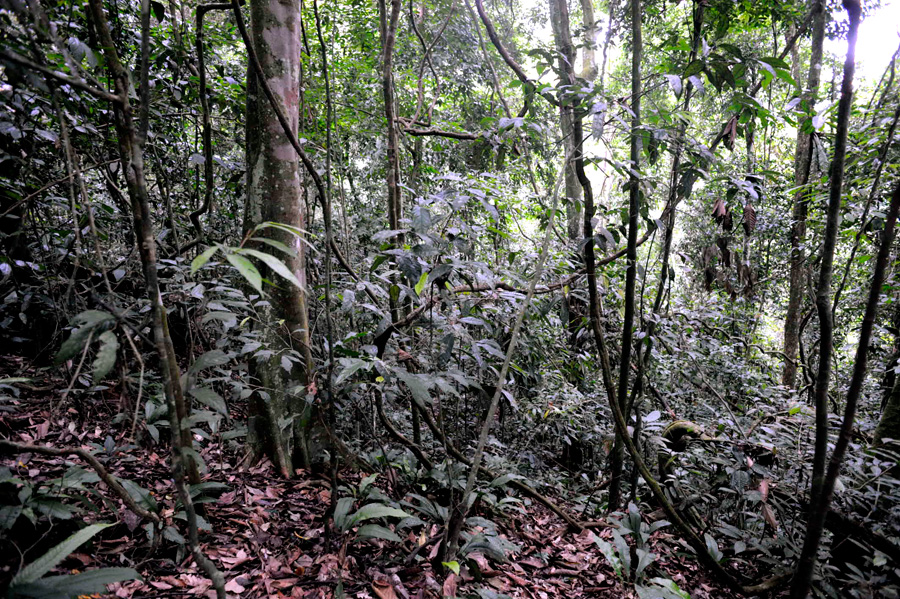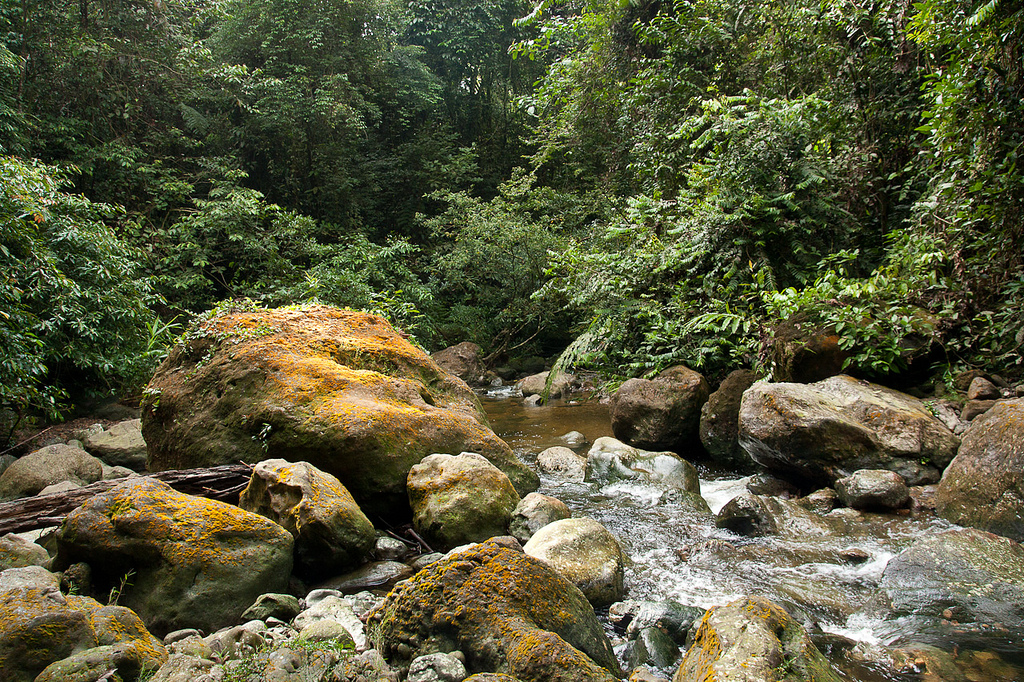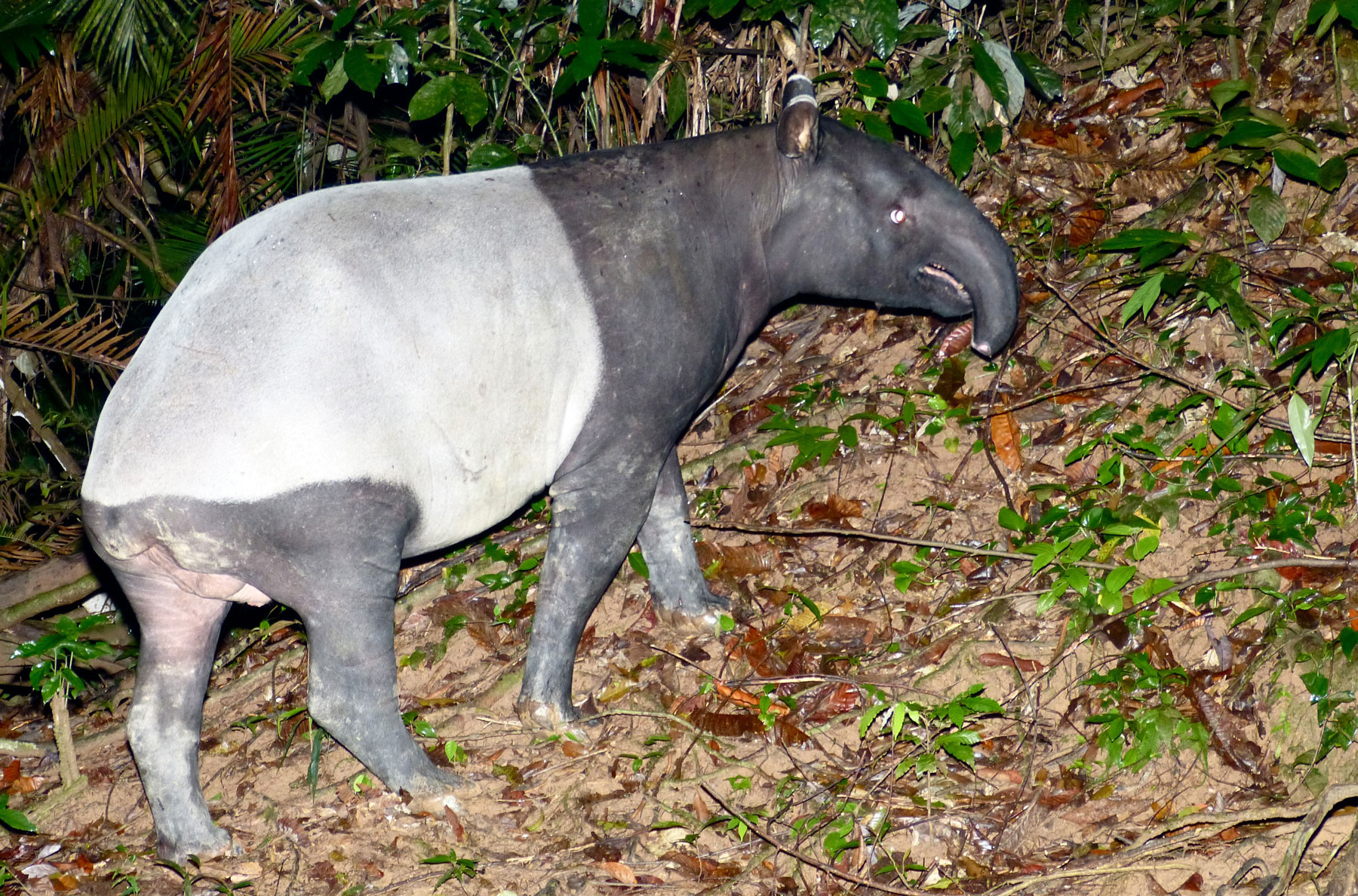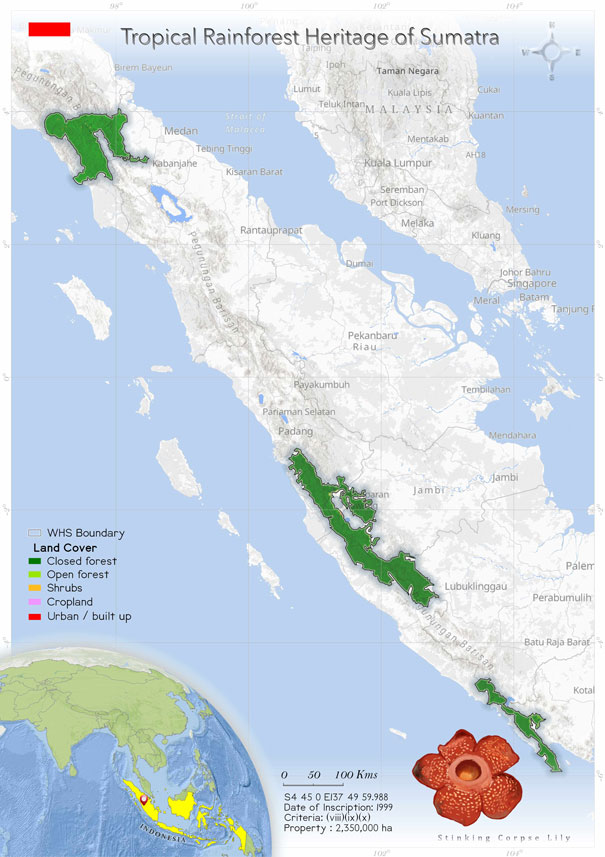
Tropical Rainforest Heritage of Sumatra (1167)
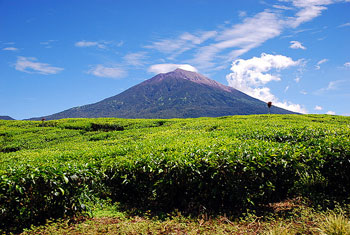 The Tropical Rainforest Heritage of Sumatra (TRHS) includes three national parks, Gunung Leuser National Park, Kerinci Seblat National Park and Bukit Barisan Selatan National Park, which makes the property one of the most significant conservation areas in Southeast Asia. The park is home to many endangered species and is important for in-situ conservation of various Sumatran species such as the Sumatran tiger, Sumatran orangutan, Sumatran elephant, Sumatran rhino and Sumatran ground cuckoo. The TRHS has various complex ecosystems such as volcanic and high-altitude lakes. There are different altitudes and topographies, fumaroles, waterfalls, cave systems and steep, rocky backdrops. The highest volcano of Indonesia, Gunung Kerinci (3805 m asl), is located in this property. TRHS also has Gunung Tujuh Lake, which is the highest lake in Southeast Asia. The park’s vegetation varies across the different altitudinal zones: from lowland rainforest, montane forest, subalpine low forest, scrub and shrub thickets, etc. This World Heritage Site comes under the category of “serial property”, consisting of three different national parks. The property also includes three biosphere reserves under UNESCO's Man and Biosphere Programme. The site has been listed as being in danger since 2011 due to various issues such as encroachment, road constructions, mining and illegal logging impacting directly on the OUV of the property. The IUCN Outlook status of the site is “Critical”. The property does not have a single plan for the entire site; instead, the national parks have individual plans.
The Tropical Rainforest Heritage of Sumatra (TRHS) includes three national parks, Gunung Leuser National Park, Kerinci Seblat National Park and Bukit Barisan Selatan National Park, which makes the property one of the most significant conservation areas in Southeast Asia. The park is home to many endangered species and is important for in-situ conservation of various Sumatran species such as the Sumatran tiger, Sumatran orangutan, Sumatran elephant, Sumatran rhino and Sumatran ground cuckoo. The TRHS has various complex ecosystems such as volcanic and high-altitude lakes. There are different altitudes and topographies, fumaroles, waterfalls, cave systems and steep, rocky backdrops. The highest volcano of Indonesia, Gunung Kerinci (3805 m asl), is located in this property. TRHS also has Gunung Tujuh Lake, which is the highest lake in Southeast Asia. The park’s vegetation varies across the different altitudinal zones: from lowland rainforest, montane forest, subalpine low forest, scrub and shrub thickets, etc. This World Heritage Site comes under the category of “serial property”, consisting of three different national parks. The property also includes three biosphere reserves under UNESCO's Man and Biosphere Programme. The site has been listed as being in danger since 2011 due to various issues such as encroachment, road constructions, mining and illegal logging impacting directly on the OUV of the property. The IUCN Outlook status of the site is “Critical”. The property does not have a single plan for the entire site; instead, the national parks have individual plans.
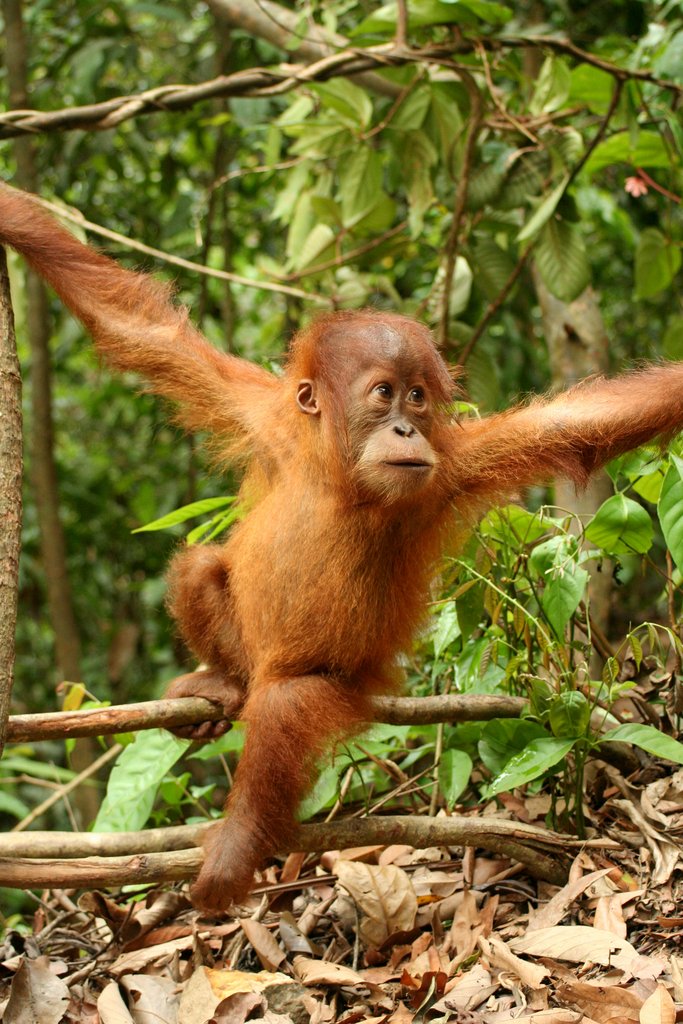 The Tropical Rainforest of Sumatra is a serial World Heritage Property that consists of three national parks. The north side of the site is known as the Leuser Ecosystem, which includes Kerinci Seblat National Park (1° 7' 13" to 3° 26' 14" S and 100° 31' 18" to 102° 44' 1' E) and Gunung Leuser National Park (2° 53' to 3° 50' N and 96° 45' to 97° 35' E). Bukit Barisan Selatan National Park (4° 29' to 5° 57' S and 103° 24' to 104° 44' E) is situated in the south of the property (Sloan et al. 2019). The Leuser ecosystem has an extent of 25,000 km2 , including the Leuser National Park and the buffer zone (Beukering et al. 2003). The property is situated at 3805 m above sea level. It is the only place in the world that is home to tigers, elephants, orangutans and rhinos (World heritage datasheet 2011). Kerinci Seblat National Park is the most significant part of this serial world heritage property (1,375,349 ha) and the second-largest terrestrial national park of Indonesia. Kerinci Seblat is also the most important habitat for the endangered Sumatran tiger, elephant and tapir (Sloan et al. 2019). The highest peak of the park and Sumatra is the active Gunung Kerinci Volcano, situated at 3805 m.
In Sumatra, most volcanoes are situated in the northern half, for example, Lembuh, in Aceh; Sinabung, Sibayak and Sorikmerapi, in north Sumatra; and Merapi and Talong, in west Sumatra (Whitten & Damanik 2012). Sumatra's tropical rainforests encompass three units included in the Man and Biosphere Programme (MAB). Giam Siak Kecil-Bukit Batu, situated in Riau Province, Sumatra, Indonesia, 705,271 ha, was declared a biosphere reserve under MAB in 2009. It is a peatland famous for sustainable timber and has two wildlife reserves. Gunung Leuser National Park was declared a biosphere reserve under MAB in 1981. It is located in north Sumatra and Aceh Province. The rainfall varies in Sumatra from 6000 mm per year, in the west of Barisan Range, to less than 1500 mm per year in some eastern areas. Sumatra is home to different types of vegetation and one of the largest tropical rainforests. It has 10,000 species of plant. There are 17 endemic genera (World heritage Datasheet 2011) of plant in the forest, with unique species such as Rafflesia arnoldii and Amorphophallus titanus, which are the largest and tallest flowers in the world, respectively. Ten per cent of the world’s flowering plants are found only in this region. Due to the different altitudinal ranges in Sumatra, the vegetation varies dramatically. The region of tall lowland forests is occupied by dipterocarp trees such as Shorea, Dipterocarpus and Dryobalanops (Whitten & Damanik 2012). There are different vegetation zones in the park, such as the lowland forests, hill forests, submontane forests, mid-and upper-montane forests, sedge–peat swamps and sub-alpine thickets. Similarly, the rainforest of Sumatra has a very diverse fauna. The property is home to 201 mammal species and 580 bird species (of which 465 are residential birds and 21 species are endemic to Sumatra). There are 200 reptile and amphibian species, and more than 30 species are found on the property. The important mammalian species of the property are the Sumatran orangutan (Pongo abelii), Malayan tapir (Tapirus indicus), Sumatran rhinoceros (Dicerorhinus sumatrensis), Sumatran tiger (Panthera tigris sumatrae), clouded leopard (Neofelis nebulosa), Sumatran striped rabbit (Nesolagus netscheri), Sumatran elephant (Elephas maximus sumatrensis), etc.
The Tropical Rainforest of Sumatra is a serial World Heritage Property that consists of three national parks. The north side of the site is known as the Leuser Ecosystem, which includes Kerinci Seblat National Park (1° 7' 13" to 3° 26' 14" S and 100° 31' 18" to 102° 44' 1' E) and Gunung Leuser National Park (2° 53' to 3° 50' N and 96° 45' to 97° 35' E). Bukit Barisan Selatan National Park (4° 29' to 5° 57' S and 103° 24' to 104° 44' E) is situated in the south of the property (Sloan et al. 2019). The Leuser ecosystem has an extent of 25,000 km2 , including the Leuser National Park and the buffer zone (Beukering et al. 2003). The property is situated at 3805 m above sea level. It is the only place in the world that is home to tigers, elephants, orangutans and rhinos (World heritage datasheet 2011). Kerinci Seblat National Park is the most significant part of this serial world heritage property (1,375,349 ha) and the second-largest terrestrial national park of Indonesia. Kerinci Seblat is also the most important habitat for the endangered Sumatran tiger, elephant and tapir (Sloan et al. 2019). The highest peak of the park and Sumatra is the active Gunung Kerinci Volcano, situated at 3805 m.
In Sumatra, most volcanoes are situated in the northern half, for example, Lembuh, in Aceh; Sinabung, Sibayak and Sorikmerapi, in north Sumatra; and Merapi and Talong, in west Sumatra (Whitten & Damanik 2012). Sumatra's tropical rainforests encompass three units included in the Man and Biosphere Programme (MAB). Giam Siak Kecil-Bukit Batu, situated in Riau Province, Sumatra, Indonesia, 705,271 ha, was declared a biosphere reserve under MAB in 2009. It is a peatland famous for sustainable timber and has two wildlife reserves. Gunung Leuser National Park was declared a biosphere reserve under MAB in 1981. It is located in north Sumatra and Aceh Province. The rainfall varies in Sumatra from 6000 mm per year, in the west of Barisan Range, to less than 1500 mm per year in some eastern areas. Sumatra is home to different types of vegetation and one of the largest tropical rainforests. It has 10,000 species of plant. There are 17 endemic genera (World heritage Datasheet 2011) of plant in the forest, with unique species such as Rafflesia arnoldii and Amorphophallus titanus, which are the largest and tallest flowers in the world, respectively. Ten per cent of the world’s flowering plants are found only in this region. Due to the different altitudinal ranges in Sumatra, the vegetation varies dramatically. The region of tall lowland forests is occupied by dipterocarp trees such as Shorea, Dipterocarpus and Dryobalanops (Whitten & Damanik 2012). There are different vegetation zones in the park, such as the lowland forests, hill forests, submontane forests, mid-and upper-montane forests, sedge–peat swamps and sub-alpine thickets. Similarly, the rainforest of Sumatra has a very diverse fauna. The property is home to 201 mammal species and 580 bird species (of which 465 are residential birds and 21 species are endemic to Sumatra). There are 200 reptile and amphibian species, and more than 30 species are found on the property. The important mammalian species of the property are the Sumatran orangutan (Pongo abelii), Malayan tapir (Tapirus indicus), Sumatran rhinoceros (Dicerorhinus sumatrensis), Sumatran tiger (Panthera tigris sumatrae), clouded leopard (Neofelis nebulosa), Sumatran striped rabbit (Nesolagus netscheri), Sumatran elephant (Elephas maximus sumatrensis), etc.
Criterion (vii)
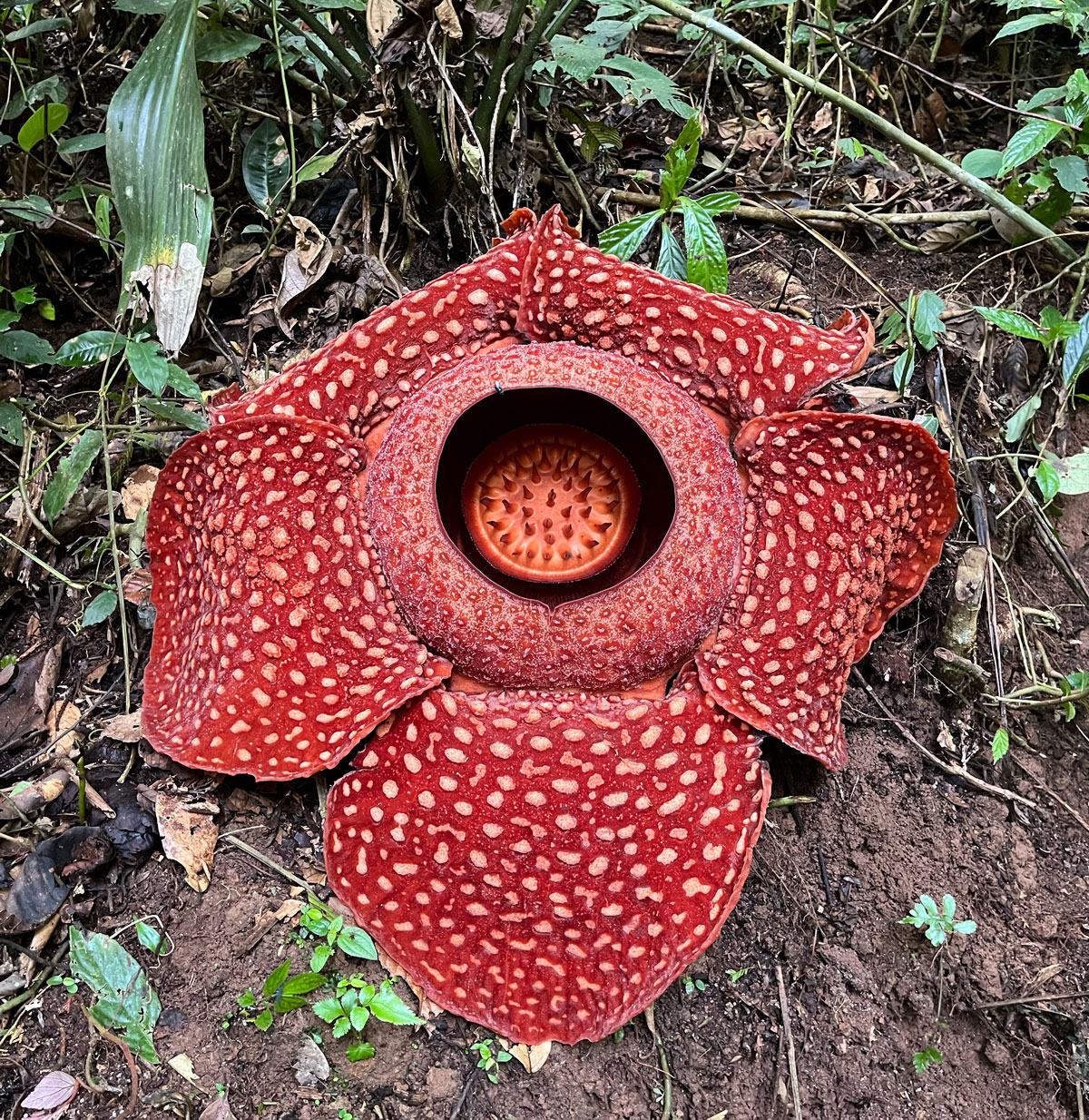 The parks that comprise the Tropical Rainforest Heritage of Sumatra are all located on the prominent main spine of the Bukit Barisan Mountains, known as the ‘Andes of Sumatra’. Outstanding scenic landscapes abound at all scales. The mountains of each site present prominent mountainous backdrops to the settled and developed lowlands of Sumatra. The combination of the spectacularly beautiful Lake Gunung Tujuh (the highest lake in southeast Asia), the magnificence of the giant Mount Kerinci volcano, numerous small volcanic, coastal and glacial lakes in natural forested settings, fumaroles belching smoke from forested mountains and numerous waterfalls and cave systems in lush rainforest settings, emphasise the outstanding beauty of the Tropical Rainforest Heritage of Sumatra. Page 269 Indonesia Tropical rainforest Heritage of Sumatra.
The parks that comprise the Tropical Rainforest Heritage of Sumatra are all located on the prominent main spine of the Bukit Barisan Mountains, known as the ‘Andes of Sumatra’. Outstanding scenic landscapes abound at all scales. The mountains of each site present prominent mountainous backdrops to the settled and developed lowlands of Sumatra. The combination of the spectacularly beautiful Lake Gunung Tujuh (the highest lake in southeast Asia), the magnificence of the giant Mount Kerinci volcano, numerous small volcanic, coastal and glacial lakes in natural forested settings, fumaroles belching smoke from forested mountains and numerous waterfalls and cave systems in lush rainforest settings, emphasise the outstanding beauty of the Tropical Rainforest Heritage of Sumatra. Page 269 Indonesia Tropical rainforest Heritage of Sumatra.
Criterion (ix)
The Tropical Rainforest Heritage of Sumatra represents the most important blocks of forest on the island of Sumatra for the conservation of the biodiversity of both lowland and mountain forests. This once vast island of tropical rainforest, in the space of only 50 years, has been reduced to isolated remnants including those centered on the three components of the property. The Leuser Ecosystem, including the Gunung Leuser National Park, is by far the largest and most significant forest remnant remaining in Sumatra. All three parks would undoubtedly have been important climatic refuge for species over evolutionary time and have now become critically important refuge for future evolutionary processes.
Criterion (x)
All three parks that comprise the Tropical Rainforest Heritage of Sumatra are areas of very diverse habitat and exceptional biodiversity. Collectively, the three sites include more than 50% of the total plant diversity of Sumatra. At least 92 local endemic species have been identified in Gunung Leuser National Park. The property contains populations of both the world’s largest flower (Rafflesia arnoldi) and the tallest flower (Amorphophallus titanum). The relict lowland forests in the sites are very important for conservation of the plant and animal biodiversity of the rapidly disappearing lowland forests of Southeast Asia. Similarly, the montane forests, although less threatened, are very important for conservation of the distinctive montane vegetation of the property
Status
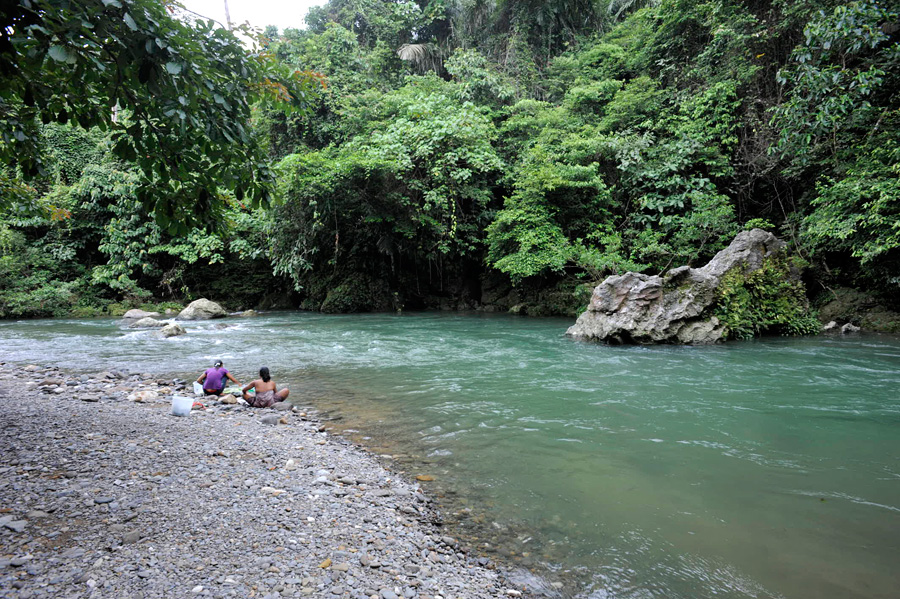 The property is under the control of the Directorate General of Forest Protection and Forest Conservation (PKHA) of the Government of Indonesia. The Indonesian Biodiversity National Strategy and Action Plan has various management plans. In 2005, the Indonesian government issued an official order against the illegal logging and saw-mill, after which the threats were eradicated. Various sectors are active at the site to reduce the other threats of the property. Anti-poaching units are active within the site, and efforts are being made to reduce the human–wildlife conflicts and encroachment activities. Encroachment is the most severe issue: there is an Indonesia-wide Anti-encroachment Task Force working at the national level to stop the issue via the Kelompok Kerja Penanganan Perambhan. Along with the site-specific law enforcement actions and encroachment eradication programmes, routine forest patrols are also carried out within the park (UNESCO whc.unesco.org).
The conversion of forests into agricultural lands is causing severe damage to the natural plant and animal species richness, and the area is getting dominated by monotonous vegetation (Klarner et al. 2017). Even though the park enjoys a protected status, the area has faced local extinction of the Sumatran orangutan, rhinoceros, tiger and elephant. The park also faces problems such as floods, erosion and loss of water supply. Illegal poaching in the Leuser National Park has pushed various species to the verge of extinction. Twenty per cent of the area of the park has already been hampered by unsustainable tourism and infrastructure development in the area (roads and bridges) (Beukering et al. 2008).
The State of Conservation report of 2019 indicates that threats such as road construction, mining, illegal logging and encroachment are the reasons the property is inscribed in the World Heritage in Danger list. Reforestation is taking place in the property with the help of the stakeholder's partnership and community participation. The expansion of invasive alien species such as Merremia peltata is one of the factors responsible for deforestation other than land conversion (State of conservation Report 2019). Decisive actions have been taken to stop the deforestation in the Aceh part of the Leuser Ecosystem by the provincial government of Aceh. The State Party is committed to not allowing geothermal energy exploration inside the boundaries of the property. To monitor the Sumatran tiger population, a guidebook has been developed, and 30 staff members have been trained. The park authorities are working to develop similar guidebooks for the Sumatran orangutan, elephant and rhino populations. The State Party developed the 2018–2021 Emergency Action Plan to breed and reintroduce the Sumatran rhinoceros. Illegal activities such as poaching and logging decreased as the patrolling in all three park elements increased after 2018 (State of conservation Report 2019). As per the recent assessment done by IUCN Outlook 2020, the property is still in a poor condition. Encroachment is still a severe threat that is affecting the OUVs of the property. The Sumatran tiger population has improved a little, which shows that anti-poaching efforts have been made, but records are lacking for the other key mammal species. Road construction inside the park’s boundaries is a threatening issue affecting the OUVs directly and causing unacceptable habitat loss.
The property is under the control of the Directorate General of Forest Protection and Forest Conservation (PKHA) of the Government of Indonesia. The Indonesian Biodiversity National Strategy and Action Plan has various management plans. In 2005, the Indonesian government issued an official order against the illegal logging and saw-mill, after which the threats were eradicated. Various sectors are active at the site to reduce the other threats of the property. Anti-poaching units are active within the site, and efforts are being made to reduce the human–wildlife conflicts and encroachment activities. Encroachment is the most severe issue: there is an Indonesia-wide Anti-encroachment Task Force working at the national level to stop the issue via the Kelompok Kerja Penanganan Perambhan. Along with the site-specific law enforcement actions and encroachment eradication programmes, routine forest patrols are also carried out within the park (UNESCO whc.unesco.org).
The conversion of forests into agricultural lands is causing severe damage to the natural plant and animal species richness, and the area is getting dominated by monotonous vegetation (Klarner et al. 2017). Even though the park enjoys a protected status, the area has faced local extinction of the Sumatran orangutan, rhinoceros, tiger and elephant. The park also faces problems such as floods, erosion and loss of water supply. Illegal poaching in the Leuser National Park has pushed various species to the verge of extinction. Twenty per cent of the area of the park has already been hampered by unsustainable tourism and infrastructure development in the area (roads and bridges) (Beukering et al. 2008).
The State of Conservation report of 2019 indicates that threats such as road construction, mining, illegal logging and encroachment are the reasons the property is inscribed in the World Heritage in Danger list. Reforestation is taking place in the property with the help of the stakeholder's partnership and community participation. The expansion of invasive alien species such as Merremia peltata is one of the factors responsible for deforestation other than land conversion (State of conservation Report 2019). Decisive actions have been taken to stop the deforestation in the Aceh part of the Leuser Ecosystem by the provincial government of Aceh. The State Party is committed to not allowing geothermal energy exploration inside the boundaries of the property. To monitor the Sumatran tiger population, a guidebook has been developed, and 30 staff members have been trained. The park authorities are working to develop similar guidebooks for the Sumatran orangutan, elephant and rhino populations. The State Party developed the 2018–2021 Emergency Action Plan to breed and reintroduce the Sumatran rhinoceros. Illegal activities such as poaching and logging decreased as the patrolling in all three park elements increased after 2018 (State of conservation Report 2019). As per the recent assessment done by IUCN Outlook 2020, the property is still in a poor condition. Encroachment is still a severe threat that is affecting the OUVs of the property. The Sumatran tiger population has improved a little, which shows that anti-poaching efforts have been made, but records are lacking for the other key mammal species. Road construction inside the park’s boundaries is a threatening issue affecting the OUVs directly and causing unacceptable habitat loss.


